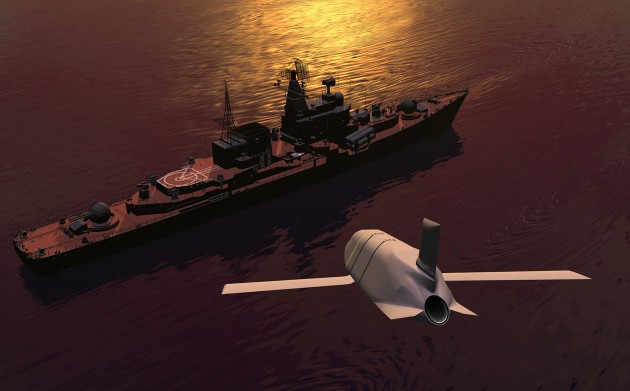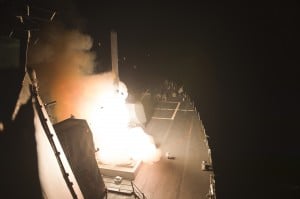Pit LRASM Against Tomahawk For Anti-Ship Missile: VADM Aucoin
Posted on

An artist’s depiction of a Lockheed Martin LRASM (Long-Range Anti-Ship Missile) hurtling towards its target.
WASHINGTON: For all the US Navy’s worldwide might, it’s painfully short on ship-killing firepower. The Pacific fleet in particular risks being “out-sticked” by longer-ranged Chinese missiles. Today, the Deputy Chief of Naval Operations outlined a plan to fill that gap. The two competing options: an update of the old, reliable Tomahawk or the new Long-Range Anti-Ship Missile.
Lockheed Martin’s LRASM, a modified Air Force missile, should compete against an upgrade of Raytheon’s Tomahawk to be the Navy’s next-generation Offensive Anti-Surface Warfare (OASuW) weapon, Vice Adm. Joseph Aucoin said today. The Navy would still buy LRASMs as an interim measure to meet the “urgent operational need” of Pacific Command, he said, but “the [long-term] follow-on to that, we will compete broadly.”
The Raytheon-built Tomahawk is famous for attacking stationary targets on land, but except for a short-lived anti-ship variant now out of service, it’s not been used against mobile or floating targets. That changed dramatically in January, when a modified Tomahawk punched a hole through a shipping container on the deck of a moving ship. (The test missile didn’t have a live warhead).

Tomahawk launch against the Khorasan group in Syria
The tech-savvy Deputy Defense Secretary, Bob Work, called the Tomahawk’s new capability a “game-changing” piece of the military’s new offset strategy.
Aucoin told reporters at the Center for Strategic and International Studies that he wants “a competition to get the best munition” possible. “What I would like to see happen is take those capabilities that we need and start inserting those into a Block IV [Tomahawk], and [compare that] to what we have with LRASM Increment 1, and have those two compete for the next-generation strike weapon,” Aucoin said. Block IV is the latest-generation Tomahawk with a new warhead and new datalinks, but it’s still limited — for now — to land targets.
“Competing LRASM and TASM [a Tomahawk Anti-Ship Missile] for the OASuW mission may be a really good idea,” said Bryan Clark, a retired Navy commander and former top aide to the Chief of Naval Operations. “The Tomahawk is a good land-attack missile and has significantly improved its survivability with Block IV, [but] it isn’t as survivable as LRASM.” Against low-tech adversaries, that may not matter. Against a sophisticated anti-access/area denial (A2/AD) defense, however, the enemy could shoot down incoming Tomahawks more easily than incoming LRASMs, so you’d have to fire more Tomahawks to ensure the same result.
On the other hand, Clark continued, the Tomahawk cost less. It also has longer range and larger payload — indeed, so much so that it’s probably overkill against enemy warships, he said. (The Tomahawk’s designed to strike targets deep inland, which by definition are further away from US Navy warships than enemy ships at sea).
“I am generally in favor of smaller weapons with less standoff range that we could carry in larger numbers,” he said, since quantity has a quality all its own.
“Another option in the mix is [Norwegian firm] Kongsberg’s Naval Strike Missile, which has about the same range and cost as LRASM” — about $2 million a missile — “but is already in production,” Clark added. “The only other options are land-attack missiles not yet adapted to [naval] surface warfare such as ATACMS or much smaller, shorter-range missiles such as Hellfire Longbow and Griffin.”
Clark recommends the Navy upgrade existing Tomahawks to the Block IV standard, plus the anti-ship capability. That would give commanders tremendous flexibility in using the same missile against either land or naval targets as needed, instead of having to allocate launch tubes exclusively to one mission or the other. “The Navy should then continue producing Tomahawk,” he said, “until the OASuW weapon, whichever wins, is developed and in production, instead of accepting a gap in surface-to-surface missile production,” as is the current plan. LRASM, meanwhile, should be made capable of attacking land targets as well as ships.
In the interests of flexibility, Clark also recommends upgrading the SM-6 Standard Missile — designed to shoot down incoming enemy missiles and aircraft — so it can strike surface ships. (The Navy’s already adding GPS to SM-6 so it can hit land targets). The SM-6 is a highly sophisticated missile defense interceptor that costs $3.5 to $4 million, roughly twice as much as a LRASM or Kongsberg NSM, he said, so it wouldn’t be the first choice for an anti-ship shot, but it would give commanders one more option in a pinch.
Is the Navy pursuing an anti-ship SM-6? I asked Aucoin and his colleague Rear Adm. Mat Winter, Chief of Naval Research.
“I don’t know if we can talk about it,” Aucoin said uncertainly. “I wouldn’t,” Winter said emphatically. We’ll take that for a “yes.”
Subscribe to our newsletter
Promotions, new products and sales. Directly to your inbox.
